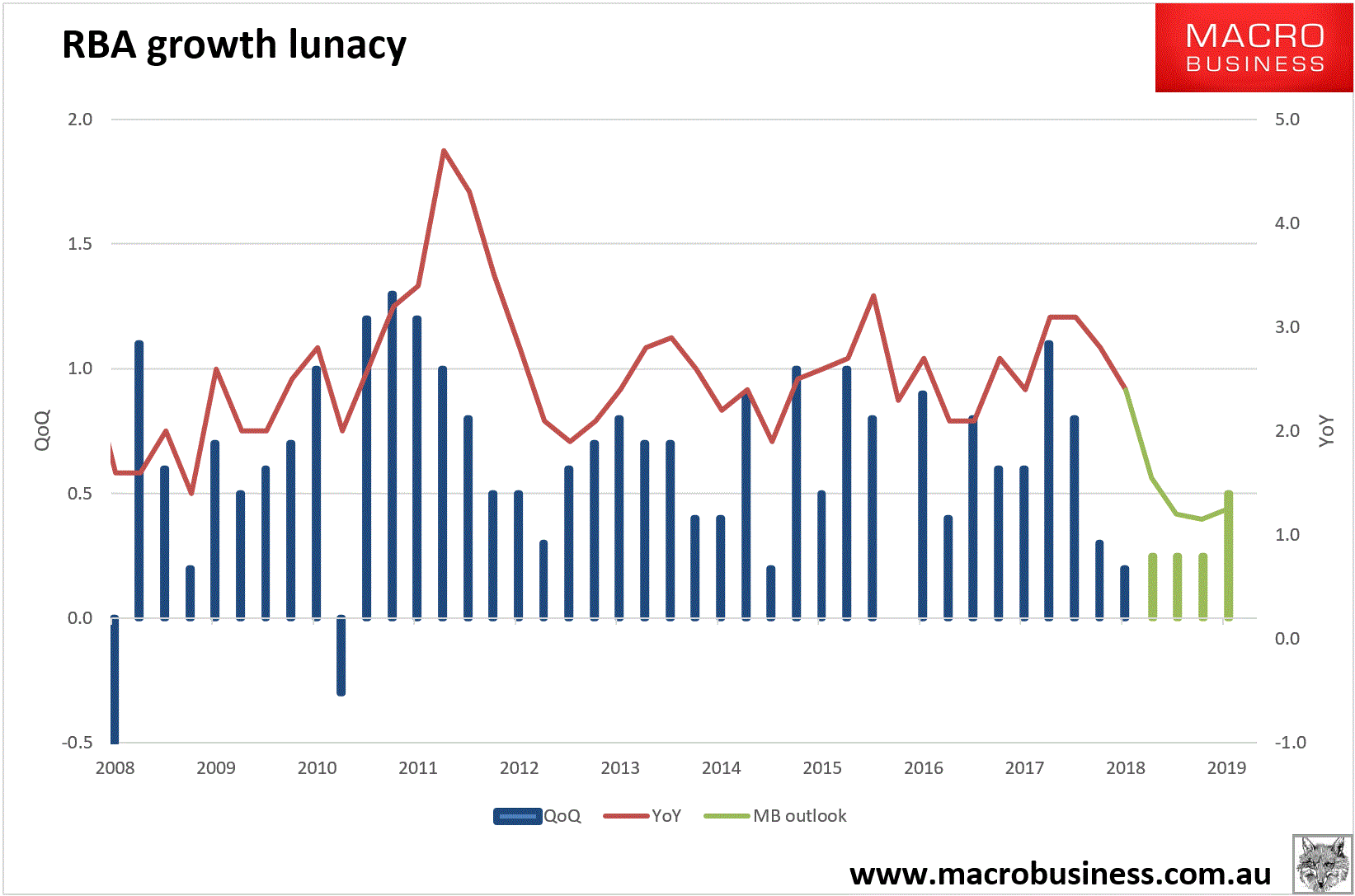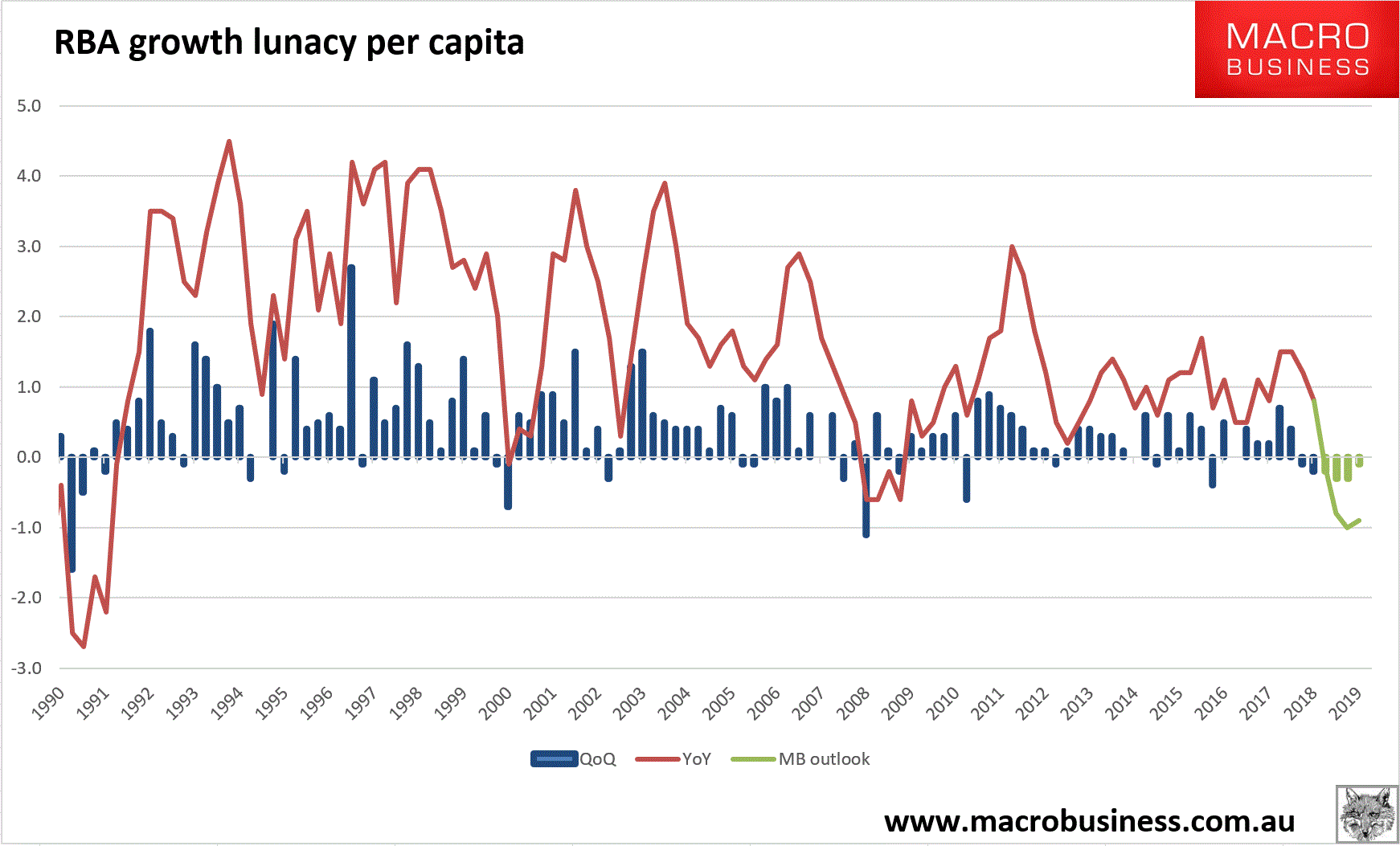If you can be bothered, there’s oodles of amateurish commentary around on the RBA today. Nobody knows what it’s going to do next given it has left the reservation of its inflation targeting regime so I won’t try.
What I will observe is that the internal ineptitude of the RBA that I’ve been pointing to for years shows no sign of abating. We know already that it has been unable to forecast its way out of a wet paper bag, but you’d expect or hope that it would learn some lessons as it went. Alas no.
Yesterday’s statement again showed the bank’s broken model of the Aussie economy in action. This is best captured by its ridiculous stochastic equilibrium algo, called Martin, which always forecasts a return to trend on everything as a matter of course. Martin appeared to punch out yesterday’s statement in his best robotic monotone:
At its meeting today, the Board decided to leave the cash rate unchanged at 1.50 per cent.
The outlook for the global economy remains reasonable, although the risks are tilted to the downside. Growth in international trade has declined and investment intentions have softened in a number of countries. In China, the authorities have taken steps to support the economy, while addressing risks in the financial system. In most advanced economies, inflation remains subdued, unemployment rates are low and wages growth has picked up.
Global financial conditions remain accommodative. Long-term bond yields are low, consistent with the subdued outlook for inflation, and equity markets have strengthened. Risk premiums also remain low. In Australia, long-term bond yields are at historically low levels and short-term bank funding costs have declined further. Some lending rates have declined recently, although the average mortgage rate paid is unchanged. The Australian dollar is at the low end of its narrow range of recent times.
The central scenario is for the Australian economy to grow by around 2¾ per cent in 2019 and 2020. This outlook is supported by increased investment in infrastructure and a pick-up in activity in the resources sector, partly in response to an increase in the prices of Australia’s exports. The main domestic uncertainty continues to be the outlook for household consumption, which is being affected by a protracted period of low income growth and declining housing prices. Some pick-up in growth in household disposable income is expected and this should support consumption.
The Australian labour market remains strong. There has been a significant increase in employment, the vacancy rate remains high and there are reports of skills shortages in some areas. Despite these positive developments, there has been little further progress in reducing unemployment over the past six months. The unemployment rate has been broadly steady at around 5 per cent over this time and is expected to remain around this level over the next year or so, before declining a little to 4¾ per cent in 2021. The strong employment growth over the past year or so has led to some pick-up in wages growth, which is a welcome development. Some further lift in wages growth is expected, although this is likely to be a gradual process.
The adjustment in established housing markets is continuing, after the earlier large run-up in prices in some cities. Conditions remain soft and rent inflation remains low. Credit conditions for some borrowers have tightened over the past year or so. At the same time, the demand for credit by investors in the housing market has slowed noticeably as the dynamics of the housing market have changed. Growth in credit extended to owner-occupiers has eased over the past year. Mortgage rates remain low and there is strong competition for borrowers of high credit quality.
The inflation data for the March quarter were noticeably lower than expected and suggest subdued inflationary pressures across much of the economy. Over the year, inflation was 1.3 per cent and, in underlying terms, was 1.6 per cent. Lower housing-related costs and a range of policy decisions affecting administered prices both contributed to this outcome. Looking forward, inflation is expected to pick up, but to do so only gradually. The central scenario is for underlying inflation to be 1¾ per cent this year, 2 per cent in 2020 and a little higher after that. In headline terms, inflation is expected to be around 2 per cent this year, boosted by the recent increase in petrol prices.
The Board judged that it was appropriate to hold the stance of policy unchanged at this meeting. In doing so, it recognised that there was still spare capacity in the economy and that a further improvement in the labour market was likely to be needed for inflation to be consistent with the target. Given this assessment, the Board will be paying close attention to developments in the labour market at its upcoming meetings.
This is the line we should focus on:
“The central scenario is for the Australian economy to grow by around 2¾ per cent in 2019 and 2020.”
Some very basic arithmetic shows how preposterous this notion is:
- we already know Q1 consumption is weak from retail volumes. The two previous quarters give the guide we need to know wider services will be soft too;
- Q2 will be weak by definition owing to the election;
- house prices are still falling fast and so long as the RBA sits around will continue to do so, even more if Labor wins and that uncertainty means Q3 will also be weak;
- business confidence and investment will follow;
- housing investment will keep falling;
- government spending is plateauing as the NBN rolls off;
- net export growth is plateauing as LNG projects roll off.
So, it’s a very good bet that the conditions that have prevailed for nearly a year now will keep going all of 2019 if left to themselves and that includes any new fiscal spending (which is already running flat chat).
To this let’s add some quarterly GDP numbers:
| Mar-2018 | 1.1 |
| Jun-2018 | 0.8 |
| Sep-2018 | 0.3 |
| Dec-2018 | 0.2 |
Notice that two very high quarterly numbers will drop out in Q1 and Q2. These will almost certainly be replaced with weak numbers resembling the last two quarters yielding this chart:

That’s right, by mid-year annual GDP growth will be around 1.3% and H1 GDP will be 0.5%. To reach the RBA’s end of year target, Q3 and Q4 will need to deliver 2.25% growth between them.
Even with some eventual pent-up demand released in Q4 when the RBA eventually cuts enough, it is not going to happen. The end result will be rising unemployment through H2 as growth craters, forcing the Bank to cut deeper and more aggressively as it risks the jobless rate feeding back into falling house prices. This might be forgivable if inflation were running riot but it’s already crashed below the target range where it has been for years.
There’s one more point to make. Assuming the current rate of immigration persists, the per capita numbers are going to be much worse, delivering a personal recession worse than the GFC:

And that is going to trash the new Labor Government before it even gets out of the blocks. The RBA knows its coming in with promised wage rises and property tax reforms. Instead it will hand over a mushrooming output gap, intensifying income recession and property crash, adding political chaos to an already gathering maelstrom.
For no reason that I can discern, the RBA has gone rogue and is crashing the economy.

